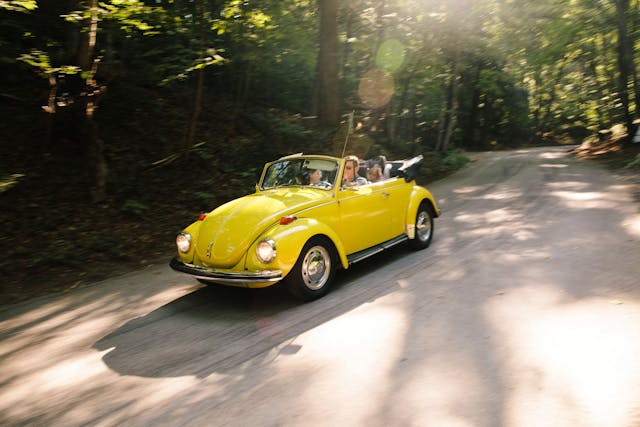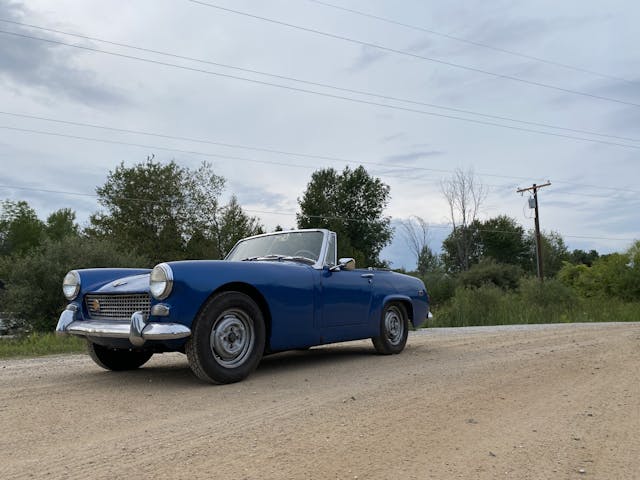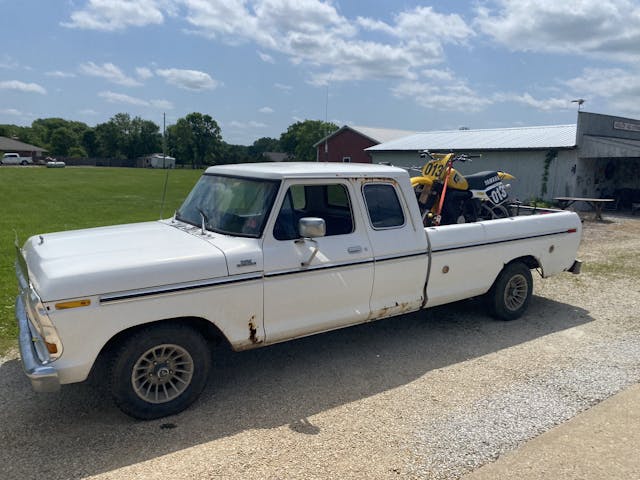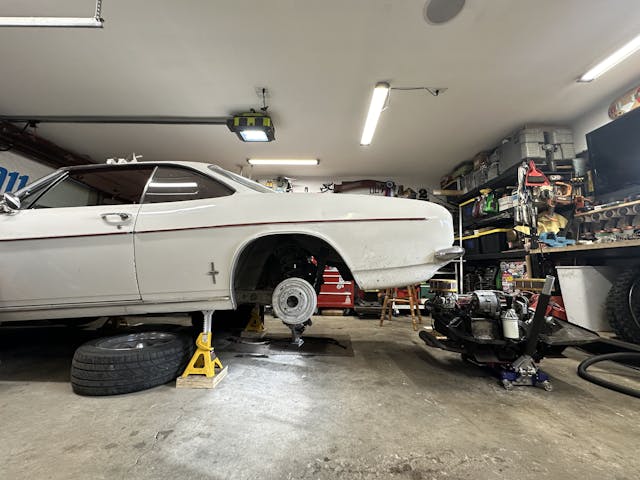Media | Articles
5 Fantastic First Project Cars
When it comes to a project car, it’s best to dive into one that truly lights a flame inside you. A project car is almost always mentally, physically, and financially draining at some point in your relationship with it. If you don’t care to stick it out through such hurdles, frustration might block you from ever returning to the project again.
So, where to begin? The list of needy cars for sale from the world’s garages, carports, driveways, and open fields can seem overwhelming. It can be easy to dream big. Of course, hell-on-wheels traps exist; certain cars are difficult to source parts for, offer minimal community and owner support, or are just plain prone to breaking.
Some cars, on the flip side, offer a stronger foundation for novices. Today we’ll be donning the role of Car Matchmaker. Whether you’re new to the hobby or a veteran, smoother-sailing and joy-to-own DIY classics are out there— here are five vehicles we think might be right for you:
Little British Cars
A cheap British sports car can offer plenty of, uh, opportunities to bond with the mechanically inclined owner. The nice thing is that there were tens of millions of Austin-Healeys, Triumphs, and MGs produced during the 1960s and ’70s that share much in terms of maintenance parts and techniques. The cars are relatively affordable, and thus, so are the parts. The biggest boon: support and knowledge provided by other enthusiasts. British car clubs are often large and helpful—perfect for a newbie to the genre.
Volkswagen Beetle

The Beetle dethroned the Model T for the outright model sales record, eventually going on to account for over 21 million sales. There is safety in numbers, which often correlates with good parts support and pricing. The aftermarket support for Bugs is downright impressive, even compared with other mainstream vintage cars like Mustangs or Chevelles. Beetle owners will get familiar with regular maintenance like oil changes and valve adjustments, but the fundamental build and design are sturdy; if you do the job right the first time, you likely won’t have to do it again unexpectedly.
Marketplace
Buy and sell classics with confidence
Ford Model A or T
You want to learn the basics? Then buy one of the most basic cars you can drive. Just stare at a Model T for more than a few minutes, and you’ll notice that none of the critical parts are hiding. Everything is pretty out in the open. Best of all, components were overbuilt by a factor or two in most areas. Model Ts—and As, for that matter—don’t require many power tools, which means they’re accessible and enjoyable to work on whether you’re a tool rookie or an experienced wrench. Fun to learn on and fun to drive? That’s a good project car.
Trucks of the 1970s and ’80
As simple as the aforementioned Fords are, their age comes with real-world usage limitations. If a utility is an aspect you value in a finished project car, vintage pickups from the 1970s and ’80s are a great place to look. These are rugged, tough hunks of metal that enjoy fairly high tolerance for deferred maintenance. If you are willing to buck up and take on the challenge of catching up on all the stuff the last owner neglected, the juice can be worth the squeeze. Fruits of your labor will include functional overdrive transmissions, disc brakes, and decent power, all baked into solid packages with relatively simple powertrains and chassis. Being trucks, they also have beds for work—or pleasure hauling. For those without a utility-focused daily driver, that’s a nice bonus when trying to justify how a collector car fits into your lifestyle.
Anything you don’t expect to daily drive
In reality, just about anything that makes you look forward to dirty hands and busted knuckles is the right project car. Expectations, however, are important; old, semi-working cars tend to behave like old, semi-working cars—they can break down and sit out of commission for extended periods. Take it from me: Spending Sunday evening underneath your car is a lot more relaxing when you don’t need the thing to get to work the next morning.
*
The whole project car process, even if it requires a long timeline, can be as rewarding as the end result. The thrill of parts finding is sometimes more thrilling than installing or even using said parts; whether buying something that requires lots of networking and parts hunting might be perfect for you, as long as you go down that road with both eyes open. Tougher endeavors in that vein hone project-car skills, but the learning curve is often steep and time-consuming. Patience is essential, so if you want more immediate gratification, relative oddball stuff like Wankel-powered NSUs or Nash Metropolitans may not be the ideal place to get your feet wet.
Find a car you think you’ll love, and the learning, fixing, and driving it all become part of the adventure. Get some experiencce under your belt and before you know it, you’ll have more than one project in the pipeline—don’t say we didn’t warn you!
***
Check out the Hagerty Media homepage so you don’t miss a single story, or better yet, bookmark it. To get our best stories delivered right to your inbox, subscribe to our newsletters.


















Good article. I have a 1969 Beetle that my father and I bought back in ‘81. It had a dead engine that required complete overhaul. We had it on the road for about a year when it got smacked from behind. He and I rebuilt it but it was never driven again until the last few years. I find myself working on it often and I suspect that if it didn’t need me to fix something on it, I would just have to sell it! It’s currently a bonafide hippie Beetle, with it’s surface rust and many paste on flowers, but I sealed it up with boiled linseed oil and it remains a very fun conversation piece when I go to shows and such.
First time project IMO should be a complete car.All the components are there.
Would also avoid “newer” cars with lots of pollution components and electronics.
The simpler the better.
ALSO not a rust bucket.A novice should concentrate on mechanical repairs not body restoration which is a skill that takes time to learn.
Back in the day it was popular to take that little British car and remove the British engine and drivetrain and install a Chevy engine and running gear and go auto crossing. Ford 289 fits were popular as well. One of the fastest at our local autocross was a Chevy Healy, good combo.
Nice list…to which is would add a Jeep.
Lots out there.
There are several iterations….so choose one and stick with it.
-Flat fender WWII military Ford/Willys. If very stock and correct, can be expensive for collectors.
-Flat fender civilian
-CJ-5/6 (pre AMC: 1955-1971)
-CJ-5/7/8 (AMC)
-M38A1 military CJ-5 1952-c1960s.
-Jeep Wrangler square headlights. mid 80d to mid 90s.
-Jeep TJ: mid 90s to mid 2000s.
You can mod them for whatever purpose you want, plenty of parts and catalogues.
When you are done, unless you do something stupid, you’ll have something PEOPLE WILL ACTUALLY WANT.
Finally, in a early topless Jeep you’ll have fun.
Probably the closest thing America ever made to the UK small convertibles.
A slight addition…
The bonus points here are (for the early models up to the ’80s square headlight YJs…metal dashboards, virtually no electronics, no plastics.
The AMC (’71 on CJs) have upgrades over the early Willys/Kaiser models…V-8s, transmission choices… and more comfortable interiors.
AMC from the mid-70s on saw the “Sport” in SUVs, so Jeeps were less basic.
If you’re a fan of GM engines, the Buick V-6 was an option in the ’60s.
If you want to restore a WWII flat fender to show standards, there is a book that will help you get it correct. You WILL need it.
A lot of post war parts will fit, but it won’t be correct and you won’t get top dollar for it.
Think of Jeeps like beetles, just because they are (sort of) look alike, does not mean that they are.
Availability of parts is key. Mustangs, Camaros, Cougars. I drive a 68 Cougar XR7 never had trouble getting a part. Ditto my 2003 Honda. Parts for Mustangs and Cougars are surprisingly cheap.
I am skeptical of “reproduction parts readily available”. My German car is 61 years old now and through the years i have replaced a lot of parts before they failed from old age. i.e. Ignition switch before I got stranded somewhere. Well guess what? The only issues I’ve had in the past decade is with the reproduction parts. I ended up putting the original 61 year old ignition switch back into the car. The new reproduction switch return spring stopped working and the flywheel kept spinning the starter. Now it appears that I will also have to replace the new reproduction door light switches. I will only mention briefly that today’s condensers are lucky to last a month. The better advice than new parts readily available is “still working original parts” or “original parts readily available”.
Regarding availability of British parts, having owned an Austin Healey 3000 for 50 years the parts availability is way better than it used to be. I’m sure MG and Triumph parts are even easier. I can get just about any part I need but not always the same supplier. Also don’t expect to get anything from Autozone or Napa. Just order it online and wait a week.
KISS keep it simple stupid as one BITOG forum noted! as noted less electronics is better, + spending on a simple but popular model may offer reasonable cost upgrades for brakes + suspension thats lacking in older cars!!
Its fun reading about the collector car choices described here.
I would like to add the list of cars owned in my lifetime, I’m 85 now and any nice collector car going by still
gets my heart beating faster ! Here’s the list, while in Australia, Europe and mostly in Canada.
#1, 37 Austin 7. #2, ? Hillman convertible. #3, 49 Vauxhall convertible, #4, 53 Holden . #5, NEW 63 Holden EJ. #6, NEW 66 Cortina 1500. #7, NEW 68 Cortina Mk 2-1600. #8, 1968 Rover 2000, #9, 1965 VW van, #10, 68 Ford Falcon 2 door. #11, 68 VW beetle. #12, 68 VW van, #13, 70 VW 412 wagon, #14, co car 85 Ford Tauris. #15, co car 1985 Pontiac 6000. #16, 1975 GMC 3/4 ton. #17 co car 88 Ford Tauris. #18, 88 F150, #19, 89 F250, #20 88 Pontiac Grand AM. #21, 2003 VW Jetta TDI, #22, 2006 VW Jetta TDI, #23, 2007 GMC Canyon.
#24, 2011 VW Golf TDI wagon. #25 76 MGB. # 26, 2015 Chevrolet Colorado extra cab, 3.6 auto trans, best truck I have ever owned. The MGB was a lot of fun to work on and drive.
Crazy question and perhaps even heresy in this forum. Are there going concerns out there that produce, either in whole or in parts, “modernized” versions of desirable classics?
I’m not sure I understand the question.
I had old beetles when I was in high school and college. Cheap, easy to work on, broke a lot.
Now I have two MGB-GTs (one for touring, one for track).
Both the beetles and the MGs are easy to work on. The trouble with a beetle is when you are done fixing it, it’s still a beetle; slow, crummy handling, and not particularly good looking.
I can’t help the “not particularly good looking” part, but there are plenty of things to make it very powerful and handle far better using the original style of suspension. If you want to take it even further there are double A-arm kits for both front and back and adding rack-and-pinion steering, modernizing the car drastically.
I can back you up on that vintage British cars are pretty reliable. I have a late 60’s British car that is very reliable and easy to work on when needed. I also have a 06 Range Rover and it is a different story. So sad what happened to the Roadster Factory.
See a Corvair in the pictures and would add they are an affordable entry level collectible. Simple project car. Lots of parts are available and the mechanics are unique and rewarding. Good community of support too. A project car is a hobby- so what if it takes 10 years to restore one? (Speaking from experience of course.)
I have an 84 Camaro since new and replaced/ redone/ refurbished almost every mechanical part on it save the steering column. It’s been a lot of fun over the years.
About 3 years ago my daughter finished with a 2012 base model civic we bought her used to get to college and her first few years at work. She beat the crap out that poor car and it’s wasn’t even worthy of trade for her new ride. 300k on the meter but the engine was OK and it ran. But it needed a lot of work. It sat in the driveway for about 6 months until I couldn’t help myself and decided to see what it needed to get on the road again. About 2500 bucks later and a whole lotsa fun in the garage I had it inspected and licensed for the road. I had more fun playing with that little civic than I’ve had for years. It may be a beater but it runs good, is a cheap ride, and fun to drive. I guess fun is where you find it my friends.
My friend, a master German automotive technician, once said to me in the 1990’s that since all the genuine German engine cases were gone, that the replacements from South America were junk. Therefore, rebuilding your Volkswagen type I through IV was a risky operation.
Sad, my second car after a 47 Chevy Stylemaster at the age of sixteen, was a 1961 Volkswagen Beetle. I wasted thousands on it trying to soup it up before switching to a 1965 Austin Mini Cooper 1275S. Now, I wish I still had that one. My true car love.
Case quality and availability has been a roller coaster ride since the ’90s. Right now they’re expensive, all are made in Brazil, and most are aluminum. The ones from Auto Linea (the original manufacturer for VW) are among the best and are sporadically available in aluminum or magnesium.
I’m fortunate enough to have a fantastic original case from the ’80s that has never seen a line-bore machine, nor does it need it, and was properly prepped for a 1600 Super Vee that was never built. It’s now the basis for a 2110 engine with big valves/ports and should be a good foundation for the (relatively) modest 150 hp I’m looking to get out of it.